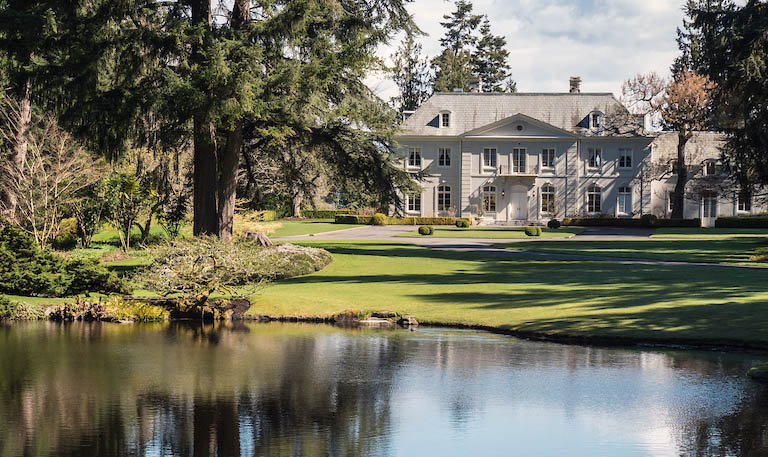“When I came here for the first time, I felt it. I got it,” says Ed Moydell, director of the 150-acre Bloedel Reserve public gardens on Bainbridge Island.
Visitors feel it too, using words like healing and magical to describe their time at the Reserve, observations usually set aside for mountain-top epiphanies.
Perhaps these feelings arise from some residual spirit of the Suquamish people. The Reserve was once part of their ancestral land, where “every part of this soil is sacred in the estimation of my people,” Chief Seattle said.
Certainly, founders Prentice and Virginia Bloedel recognized the restorative power of nature in this place, which is why, in the 1950s, decades ahead of their time, they began to turn forested acreage into a series of meticulously curated landscapes, while funding scientific research to study the effects of nature on people.
“In many ways, it was a life’s work. It was all about providing the opportunity for people to connect with nature meaningfully,” says Moydell, adding that the couple worked with the era’s pioneers of horticultural therapy “before it was a thing.”
The son of a timber baron, Prentice reluctantly followed his father into the family business but even there, he managed to introduce ideas of conservation, promoting the reforestation of clear cuts.
Believing their botanical legacy belongs to the people, the Bloedels eventually gave the land for public use so everyone could find solace in their creation.
Now, in just a couple of hours, it’s possible to wander the two-mile trail that meanders through forests, past water features fed by natural springs, through a primeval gathering of mosses and massive stands of rhododendrons, as well as a formal Japanese garden with carefully raked stones that whorl around boulders like water. And thanks to timed-ticket admissions, there’s plenty of space between visitors.
For those wishing to take a deep dive into this special place—and themselves—there’s the popular, self-guided Strolls for Well-Being. Launched in 2014, the program encourages participants to immerse themselves in the Reserve’s bounty while on a journey of self-discovery. Guided by a beautifully illustrated book, there are 12 themes to investigate, beginning with awareness and ending with fulfillment, explored in specific landscapes. Three meetings offer structure and camaraderie—an orientation, another at mid-point, and a closing wrap-up. Best of all, those taking part receive a free six-month Reserve membership in which to complete the strolls.
During the pandemic, the program was an online and in-person hybrid, but not this year. “We’re bringing back the full experience,” says Nature and Well-Being Program Manager Robin Gaphni. “My goal is to create a safe space as people explore these landscapes.”
There’s also a Strolls at Home program using materials developed during the COVID-19 shutdown. Instructions and prompts are accessed online to use while exploring neighborhoods, local parks, or backyards.
In addition, the Bloedel Reserve offers an eight-week grief program, with small groups meeting at the Japanese Guest House. Offering a combined 50 years of experience working with the bereaved, Gaphni and retired psychiatrist Ted Rynearson lead the discussions. “What people may not understand is that grief is not linear,” Gaphni says. “There’s you before, and there’s you after, building a new identity.”
No matter why you visit, the Bloedel Reserve meets you where you are, offering something not found anywhere else, says Etta Lilienthal, communications manager at the Reserve. “It has an ineffable quality. This isn’t just a walk in the woods. You can be with nature anywhere but what makes this place so unique is that people feel deeply connected here.”
Director Moydell agrees. “One thing that makes it special is that the Reserve feels mature, even though it’s been logged twice in the past and open to the public for only 35 years. It’s a great place to be a plant,” he says, “or a person.”
Connie McDougall is a former news reporter and current freelance writer of nonfiction and personal essays. A lifelong student and proud English major, she has pursued lessons in flying, scuba diving, tai chi, Spanish, meditation, hiking, and Zumba.
If you go
For more information including hours and admission, visit bloedelreserve.org/.
The Strolls for Well-Being program, which offers a free six-month membership, is open to new participants only:
Spring session March 22-May 6
Summer session June 14-Sept. 9
Fall session Sept. 13-Dec. 9
Grief groups meet for eight weeks, Thursday afternoons from 1-3 p.m., and receive a free six-month membership as well as the Strolls for Well-Being guidebook:
Feb. 9-March 30
April 20-June 8
Sept. 28-Nov. 16


